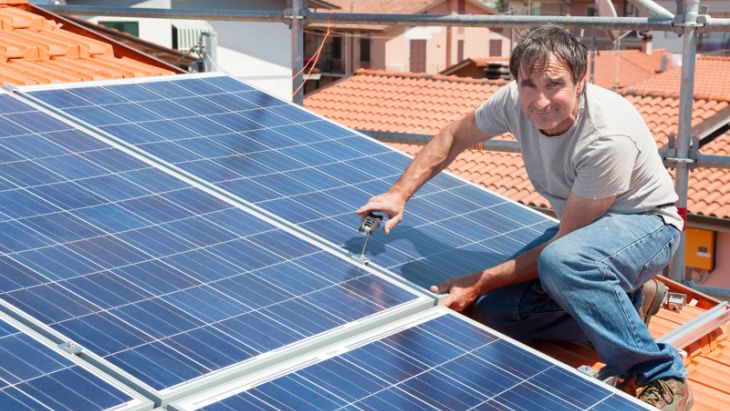Every time I enter Facebook, I see advertisements from businesses promoting various offers for the installation of a photovoltaic panel system because I am interested in the topic of prosuming. I responded to such an ad and received the details. Below you will find an analysis of the offer and some considerations about it.
Technical and financial offer
For an individual household with an average monthly consumption of 500 kWh, I requested a 3 kW photovoltaic system. The offer received includes 8 panels with an individual power of 410/415 W and a Huawei hybrid inverter with a power of 3 kW single-phase, at a price of 27,000 lei, VAT included (5,428 euros). Included are the fastening system, mounting structure, cables, and connections, as well as consulting services, including building evaluation. “The dedicated agent takes care on your behalf of submitting all the documents, signing and paying the necessary fees for drawing up the file, and obtaining the technical approval for the connection,” so that I can become a prosumer.
The offer also comes with the option of payment in 60 equal installments of 587 lei (118 euros), which makes the total investment 35,220 lei (7,080 euros).
Finally, the offer received is valid only with the switching supplier and is accompanied by a bonus of 700 lei, VAT included (140 euros). Thus, the total investment becomes 28,220 lei (5,673 euros).
Financial analysis
With a monthly consumption of 500 kWh, depending on the existing supplier, the power bill can be, at best, 386 lei (0.77 lei/kWh) [77.5 euros (0.154 euro/kWh)] or, in the most common situation, 650 lei (1.30 lei/kWh) [130 euros (0.261 euro/kWh)], as it results from the 23 suppliers’ offers generated by the price comparator on the ANRE website.
If we take into account an average daily production of 10 kWh, it means that we can rely on our own production of around 300 kWh per month. As a result, we can anticipate a reduction in the monthly bill of 390 lei (78.4 euros); we have taken into account a supply price of 1.30 lei per kWh.
With the installation of the photovoltaic system under these conditions, the amount of the bill to be paid each month would be reduced to 260 lei (52.2 euros). The monthly rate for the system (587 lei, which is 118 euros) and the amount of the bill for the difference in energy that the photovoltaic system that I installed does not produce (260 lei), however, would total 847 lei (170 euros) over a period of five years.
In conclusion, for the next 5 years, with the installation of a photovoltaic system under the conditions described above, the cost of energy would increase from 386 (77.5) to 847 lei (170 euros) (if you currently have Hidroelectrica as a supplier) – 120%, or from 650 (130 euros) to 847 lei (170 euros) (if you currently have another supplier) – 30%. From the 6th year on, the monthly cost of electricity, calculated at current market prices, would decrease to only 260 lei, a reduction of 32% for the first situation and 60%, respectively, for the second situation.
What we don’t know: prices, consumption, and our own production
Obviously, we don’t know how prices will evolve in the future. If they remain close to today’s, the calculations remain valid. If prices fall, the financial benefits of the PV system will decrease, and if supplier prices increase, the financial benefits of the PV system will turn out to be higher than we have calculated here.
We do not know how household consumption will evolve in the future. If we reduce the number of consumers or use more efficient equipment (refrigerator, washing machine, and/or clothes dryer, dishwasher, etc.), the financial benefits of the photovoltaic system will prove to be higher because the own production will cover more of the consumption. But if we increase consumption (more people in the household, outdoor lighting, an electrically powered garden watering system, electrification of heating through heat pumps or air conditioning systems, electrification of cooking through an electric oven, etc.), our own production will cover more of the consumption. The financial benefits of the PV system will be maximised, but the bill may increase.
Finally, we do not know what the volume of our own production will be. In the situation where our neighbours have already installed or will install their photovoltaic systems and the distribution system to which we are connected cannot accept the entire instantaneous production, the inverters will be automatically turned off, and the photovoltaic system will not produce at all exactly at the best solar potential. The efficiency of the PV system is not (cannot be?) guaranteed by the installer or the distribution operator, so there is a risk that the financial benefits will turn out to be (much) lower.
But what if we add a battery storage system?
Installing a battery system would reduce this risk and eliminate this uncertainty, maximising the financial benefits of the PV system.
The offer from the same installer includes a 5 kW single-phase storage system at a total price of 40,887 lei, with a bonus of 700 lei, which means a final investment for the future prosumer of 40,187 lei (8,078 euros), 12,000 lei (2,412 euros) more than the PV system without storage. However, the offer received no longer includes the option of payment in installments, so the entire amount must be paid at once.
The storage system comes with two other advantages: it increases the rate of use of its own production (which reduces the value of the final electricity bill) and allows a maximum degree of independence from the perspective of electricity since the home is no longer affected by interruptions in the network.
Conclusions
The final decision depends on the situation of each individual home owner. Currently, for most situations, installing a PV panel system is primarily an investment to reduce your CO2 footprint and create a greener future, not necessarily a business. In the first 5 years, electricity costs are higher, not lower, and the recovery of the investment depends on developments that are difficult to anticipate or that cannot be controlled by the prosumer (prices, consumption, level of own production). Installing a storage system means an additional investment that mainly contributes to an increased degree of comfort.
In situations where the home is relatively far from the electricity distribution network, becoming a prosumer is a much better option.
Although commercial offers are more and more numerous, the financial calculations are not sufficiently stimulating. There is still a need for support schemes such as the subsidisation of the purchase and installation of photovoltaic systems by natural persons to become prosumers (PV Green House program of the Environment Fund Administration, AFM). They must be better managed and include subsidies for the purchase and installation of storage systems.

